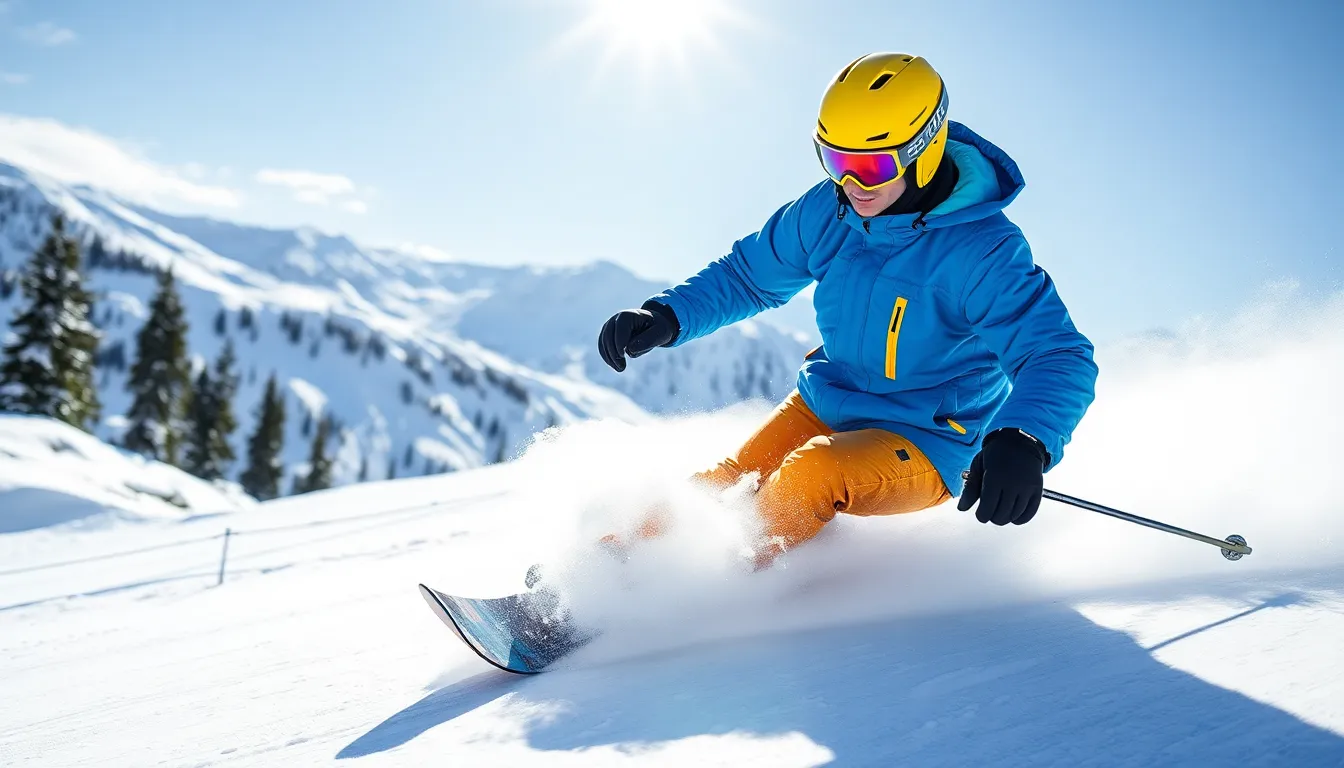As winter approaches, thrill-seekers gear up for exhilarating adventures on the slopes. However, with the excitement of skiing, snowboarding, and other winter sports comes the need for a safety net. Winter sports travel insurance is essential for anyone planning to hit the mountains, offering protection against unexpected mishaps that could derail a perfect trip.
This specialized insurance provides coverage for injuries, equipment loss, and even trip cancellations. Without it, skiers and snowboarders risk facing hefty medical bills or losing their investment in travel. Understanding the importance of winter sports travel insurance can make all the difference in ensuring a worry-free experience on the slopes.
Table of Contents
ToggleUnderstanding Winter Sports Travel Insurance
Winter sports travel insurance provides coverage tailored for individuals engaged in snowy activities like skiing and snowboarding. This insurance safeguards against various risks, ensuring participants can enjoy their time on the slopes without worry.
What Is Winter Sports Travel Insurance?
Winter sports travel insurance is a specialized policy designed for travelers participating in winter sports. It typically includes coverage for medical expenses resulting from accidents, trip cancellations, and loss or damage to personal gear. Policies may also encompass liability coverage, protecting against third-party injuries, and rescue operations following accidents. Essential details include the duration of coverage, specific sports included, and any exclusions, like off-piste skiing.
Why Is It Important?
Winter sports travel insurance is crucial due to several factors:
- Accident Coverage: Winter sports can lead to severe injuries, including fractures and concussions. Insurance ensures immediate medical treatment without overwhelming out-of-pocket costs.
- Equipment Protection: Coverage for lost, stolen, or damaged equipment provides peace of mind, especially considering that skiing and snowboarding gear can be expensive.
- Trip Cancellations: Unexpected events, such as illness or bad weather, may cause trip alterations. Insurance often reimburses non-refundable expenses, mitigating financial losses.
- Rescue Expenses: Ski-related accidents can necessitate costly rescue operations. Insurance typically covers these expenses, ensuring participants receive timely assistance.
- Liability Coverage: Protecting against claims from third parties makes this insurance a smart choice for individuals involved in potentially hazardous sports.
Understanding the significance of winter sports travel insurance promotes safer and more enjoyable experiences on the slopes.
Coverage Options

Winter sports travel insurance offers various coverage options tailored for snow enthusiasts. Understanding these options ensures individuals can select policies that best meet their needs.
Types of Coverage Available
- Medical Expenses: Coverage includes hospital stays, emergency treatment, and medical evacuation. Policies typically cover serious injuries like fractures or concussions sustained during winter sports.
- Trip Cancellation or Interruption: This covers non-refundable costs if a trip is canceled or interrupted due to unforeseen circumstances such as illness or severe weather. Insured amounts vary by policy.
- Equipment Coverage: This protects against loss, theft, or damage to personal ski or snowboard equipment. Policies often reimburse the repair costs or provide replacement options for high-value items.
- Emergency Evacuation: Coverage ensures that individuals can receive emergency transport from remote ski locations, which can be expensive without insurance.
- Liability Protection: This coverage protects against claims from third parties for injuries or damages caused while participating in winter sports activities.
Exclusions to Consider
- Pre-existing Conditions: Many policies do not cover injuries or illnesses arising from pre-existing medical conditions. Insurers often define what constitutes a pre-existing condition, so careful review is necessary.
- Negligent Behavior: Coverage may exclude injuries resulting from reckless actions, like skiing off marked trails or engaging in prohibited activities.
- Weather-Related Cancellations: Policies might not cover cancellations due to weather, particularly if skiing conditions remain safe. Review the specific terms to understand these limitations.
- Professional Sports: Injuries incurred while participating in professional competitions often fall outside policy coverage. Most insurers cater to recreational users, not professional athletes.
- Unapproved Activities: Participants engaging in extreme winter sports without obtaining adequate coverage face exclusions. Activities such as heli-skiing or snowmobiling may require additional policies.
Choosing the Right Policy
Choosing the right winter sports travel insurance policy involves careful consideration of multiple factors. Evaluating coverage options and comparing providers can significantly impact overall protection and cost.
Factors to Consider
- Coverage Type: Review the specific coverage types required, such as medical expenses, trip cancellation, or equipment loss.
- Coverage Amount: Assess suitable coverage limits based on potential expenses, including medical bills, equipment costs, or trip investments.
- Exclusions: Identify critical exclusions in each policy, like pre-existing conditions or injuries incurred during professional competitions.
- Duration of Coverage: Consider policies that cover the entire duration of the trip, including any activities outside of scheduled winter sports.
- Emergency Assistance: Look for providers offering 24/7 assistance services for emergencies, enhancing peace of mind while traveling.
- Cost: Compare premium rates while balancing coverage benefits to ensure comprehensive protection fits within budget constraints.
Comparing Different Providers
- Reputation: Evaluate providers based on customer reviews and ratings, focusing on reliability during high-stress situations.
- Policy Flexibility: Examine options for customizing policies, allowing adjustments based on unique travel needs and activities.
- Claims Process: Investigate the simplicity of the claims process for each provider, as straightforward procedures make managing incidents less stressful.
- Assistance Features: Compare added services, such as connections to local healthcare providers or support with bookings during emergencies.
- Policy Bundles: Explore bundled travel insurance options with other travel-related policies, which can lead to cost savings and increased convenience.
- Comparison Tools: Utilize online comparison tools to analyze multiple policies side by side, streamlining the decision-making process and ensuring suitable coverage.
Tips for Travelers
Travelers engaging in winter sports should follow key tips to enhance their experience and ensure they are properly covered. These tips focus on preparation and understanding how to navigate insurance claims effectively.
Preparing for Your Winter Sports Trip
- Research Insurance Options: Evaluate multiple insurance providers for suitable plans that cover specific winter activities.
- Check Coverage Details: Confirm that the policy covers medical expenses related to skiing or snowboarding injuries, equipment loss, and trip cancellations.
- Understand Exclusions: Recognize exclusions such as pre-existing conditions, reckless behavior, or injuries arising from professional competitions.
- Document Your Gear: Create an inventory of personal sports equipment, including model numbers and purchase receipts, to expedite claims for lost or damaged items.
- Use Safety Gear: Invest in protection gear such as helmets and padding to minimize the risk of injuries while participating in winter sports.
- Stay Informed on Weather Conditions: Monitor weather forecasts to anticipate possible cancellations and understand potential policy implications.
Filing a Claim
- Notify Your Insurance Provider: Contact the insurance company as soon as a loss, injury, or cancellation occurs to start the claims process.
- Gather Necessary Documentation: Compile all pertinent information, including medical reports, receipts for equipment, and evidence of canceled travel arrangements.
- Provide Detailed Accounts: Offer specific narratives of incidents leading to the claim, including dates, locations, and descriptions of events or injuries.
- Follow Claims Procedures: Adhere to the specific claim-filing procedure outlined by your insurance provider to avoid delays.
- Keep Copies of Everything: Maintain records of all correspondence and documents submitted to facilitate effective communication with the insurance company.
Winter sports travel insurance is an essential component for anyone planning to hit the slopes. It not only safeguards against unexpected medical expenses but also protects valuable equipment and trip investments. By understanding the various coverage options and exclusions, travelers can make informed decisions that enhance their overall experience.
Taking the time to compare policies and providers ensures that individuals find the right fit for their needs. With proper coverage in place, winter sports enthusiasts can focus on enjoying their adventures without the stress of potential financial setbacks. Embracing this peace of mind allows for a more exhilarating and enjoyable winter sports experience.





